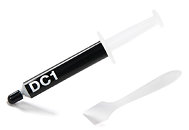Tuesday, February 26th 2013
Be Quiet! Announces DC1 Thermal Interface Material
be quiet!, market leader for power supplies in Germany for seven years in a row*, announced today the availability of the new high performance thermal compound DC1. The new paste is the logical extension of the award-winning cooler portfolio of the German company. With its excellent heat conducting properties and its extremely simple handling, the paste is suitable for both normal users and Overclockers.
Through the perfect combination of metal oxides and silicon the new be quiet! thermal compound DC1 has a theoretical thermal conductivity of about 7.5 W / mK. Thus it offers several degrees Celsius advantage over conventional thermal compounds, as used for example in many ready-build-systems. Overclockers can also improve their results with the DC1. Thanks to a wide temperature range of -50 to +150 ° C, DC1 is suitable for various cooling methods.Its unique composition allows the paste to be applied easily. be quiet! 's DC1 comes in a handy syringe, which allows for a neat and tidy application onto the CPU die. For a perfect and planar layer of thermal compound there is an extra enclosed spatula. A syringe with 3 grams of be quiet!'s DC1 costs EUR 6.49 and is available in stores now.
Through the perfect combination of metal oxides and silicon the new be quiet! thermal compound DC1 has a theoretical thermal conductivity of about 7.5 W / mK. Thus it offers several degrees Celsius advantage over conventional thermal compounds, as used for example in many ready-build-systems. Overclockers can also improve their results with the DC1. Thanks to a wide temperature range of -50 to +150 ° C, DC1 is suitable for various cooling methods.Its unique composition allows the paste to be applied easily. be quiet! 's DC1 comes in a handy syringe, which allows for a neat and tidy application onto the CPU die. For a perfect and planar layer of thermal compound there is an extra enclosed spatula. A syringe with 3 grams of be quiet!'s DC1 costs EUR 6.49 and is available in stores now.



8 Comments on Be Quiet! Announces DC1 Thermal Interface Material
I personally put a small dot on the chip and use some sort spatula or flat surface (credit card) and spread it evenly over the whole chip. I can not see through it but it is so thin that if I even so much as touch it it leaves a bare spot. I do this to every video card I get and it always gets me at least 3c cooler, or my record of 15c because saphire put it 1mm thick.
I use artic mx-4 which I don't think can be laid thin enough to be seen through.